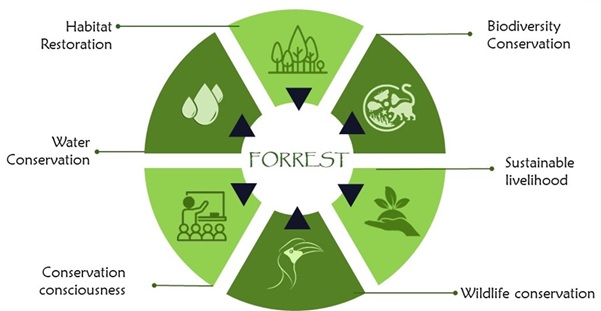| GS Paper-III – Environment and Ecology |

Forest conservation in India is not only environmental but also deeply rooted in cultural and spiritual traditions:
- Vedic Era: Forests were revered as Vandevata or Aranyadevata (forest deities).
- Maurya & Gupta Periods: Early state forest policies existed.
- Kautilya referred to forests as “state property” in Arthashastra.
- British Period:
- 1864 – Establishment of Imperial Forest Department.
- Indian Forest Act, 1878 (later revised in 1927) centralized forest control.
- Post-Independence:
- Forest conservation was linked with developmental goals.
- 1976 – 42nd Constitutional Amendment moved “Forests” from State List to Concurrent List, giving both Union and States policymaking authority.
Current Status of Forests in India (ISFR 2023)
|
Indicator
|
Data / Source
|
|
Total Geographical Area
|
3,287,469 sq km
|
|
Total Forest Cover
|
25.17%
|
|
Tree Cover
|
2.91%
|
|
Total Forest + Tree Cover
|
28.08%
|
|
State with Highest Forest Cover
|
Mizoram (84.53%)
|
|
State with Lowest Forest Cover
|
Haryana (3.62%)
|
|
Very Dense Forest
|
3.04% of total area
|
|
Moderately Dense Forest
|
9.33%
|
|
Open Forest
|
12.80%
|
|
Mangrove Area
|
5,992 sq km (0.1% increase)
|
Economic and Ecological Importance of Forests
(i) Economic Contribution
- Forests contribute ~1.5% directly to GDP, with much higher indirect contribution.
- Non-Timber Forest Products (NTFPs) like lac, tendu leaves, resin, medicinal plants support the livelihoods of 27.5 million rural people.
- Estimated value of ecosystem services: ~$120 billion/year.
(ii) Ecological Benefits
- Carbon Sink: Indian forests absorb ~24,000 million tons of CO₂.
- Soil conservation, water resource protection, biodiversity support, microclimate regulation.
- Mangroves protect coasts from erosion and storms.
(iii) Social & Cultural Significance
- ~3,000 tribal communities depend on forests for livelihood and culture.
- Sacred Groves in 12 states act as “living museums of biodiversity.”
Key Challenges
- Deforestation:
- 3.3% tree cover lost (2001–2022, Global Forest Watch).
- Driven by mining, urbanization, roads, and dams.
- Forest Fires:
- ~36% forest area annually prone to fires.
- High-risk states: Odisha, Chhattisgarh, Maharashtra, Manipur.
- Climate Change:
- Rising temperatures, erratic rainfall, droughts → higher tree mortality.
- Illegal Logging & Timber Trade.
- Human-Wildlife Conflict:
- Expansion of settlements vs conservation of tigers, elephants, leopards.
- Afforestation vs Natural Forests:
- Monoculture plantations reduce ecological diversity.
Institutional and Legal Framework
|
Act / Institution
|
Description
|
|
Indian Forest Act, 1927
|
Forest administration, crime, timber trade regulations.
|
|
Forest (Conservation) Act, 1980
|
Prohibits non-forest use without central approval.
|
|
Amendment Act, 2023
|
Clarified “forest,” exempted boundary areas & security projects.
|
|
Forest Rights Act, 2006 (FRA)
|
Recognizes rights of tribal and traditional forest dwellers.
|
|
National Forest Policy, 1988
|
Target: 33% forest cover.
|
|
T.N. Godavarman Case (1996)
|
Supreme Court defined “forest” broadly; Green Bench established.
|
|
Constitution Article 48A
|
State duty: protect environment & forests.
|
|
Constitution Article 51A(g)
|
Citizen duty: protect environment & forests.
|
Major Government Initiatives
- Green India Mission (2014): 10 million hectares reforestation in 10 years.
- Compensatory Afforestation Fund (CAMPA): ₹66,000+ crore allocated to states by 2023.
- National Afforestation Programme (NAP): Village-level forestry via JFMCs.
- Eco-Task Forces (ETF): Army-assisted afforestation, water conservation, land rehabilitation.
- National Bamboo Mission (NBM): Promote bamboo as “green gold.”
- Digital Forest Mapping: Real-time monitoring with GIS, drones, satellite imagery.
Global Initiatives India is Part Of
|
Initiative
|
Objective
|
|
REDD+
|
Reduce emissions from deforestation; provide economic incentives.
|
|
Bonn Challenge
|
Restore 350 million hectares by 2030.
|
|
UN Decade on Ecosystem Restoration (2021–2030)
|
Restore degraded ecosystems.
|
|
Global Forest Vision 2030
|
Restoration, recovery, regeneration via 8 priority actions.
|
|
Paris Agreement NDCs
|
Create additional carbon sink of 2.5–3 billion tons CO₂.
|
Best Practices
|
Region / Country
|
Initiative
|
Result
|
|
Japan
|
Forest Environment Tax
|
Sustainable revenue for forest conservation.
|
|
Congo Basin
|
Forest Partnership Initiative
|
Protects Africa’s “lungs of the world.”
|
|
Kerala, India
|
Miyawaki Urban Forests
|
Dense urban forests with local biodiversity.
|
|
Sikkim, India
|
Community Forest Management
|
Panchayats monitor & regenerate community forests.
|
Way Forward
- Link conservation to economic policy:
- Implement Green GDP & Natural Capital Accounting.
- Empower local communities:
- Effective implementation of Forest Rights Act.
- Climate-smart forestry:
- Use native species; biodiversity-focused plantations.
- Enhance community participation:
- Transparent Joint Forest Management.
- Forest fire management:
- AI-based alert systems; firebreak zones.
- Legal reforms:
- Align Forest (Conservation) Act with Environmental Impact Assessment (EIA).
- Education & Awareness:
- Promote “Green Club” culture in schools and colleges.
Conclusion
- India’s forest conservation efforts are integral to environmental policy, national security, climate responsibility, and social justice.
- India demonstrates that development and environmental protection can complement each other.
- A green and secure future depends on every citizen adopting forest preservation in daily life.



